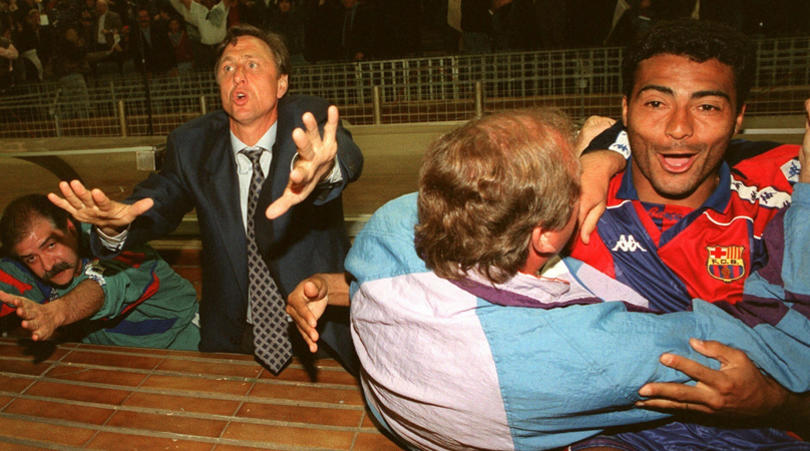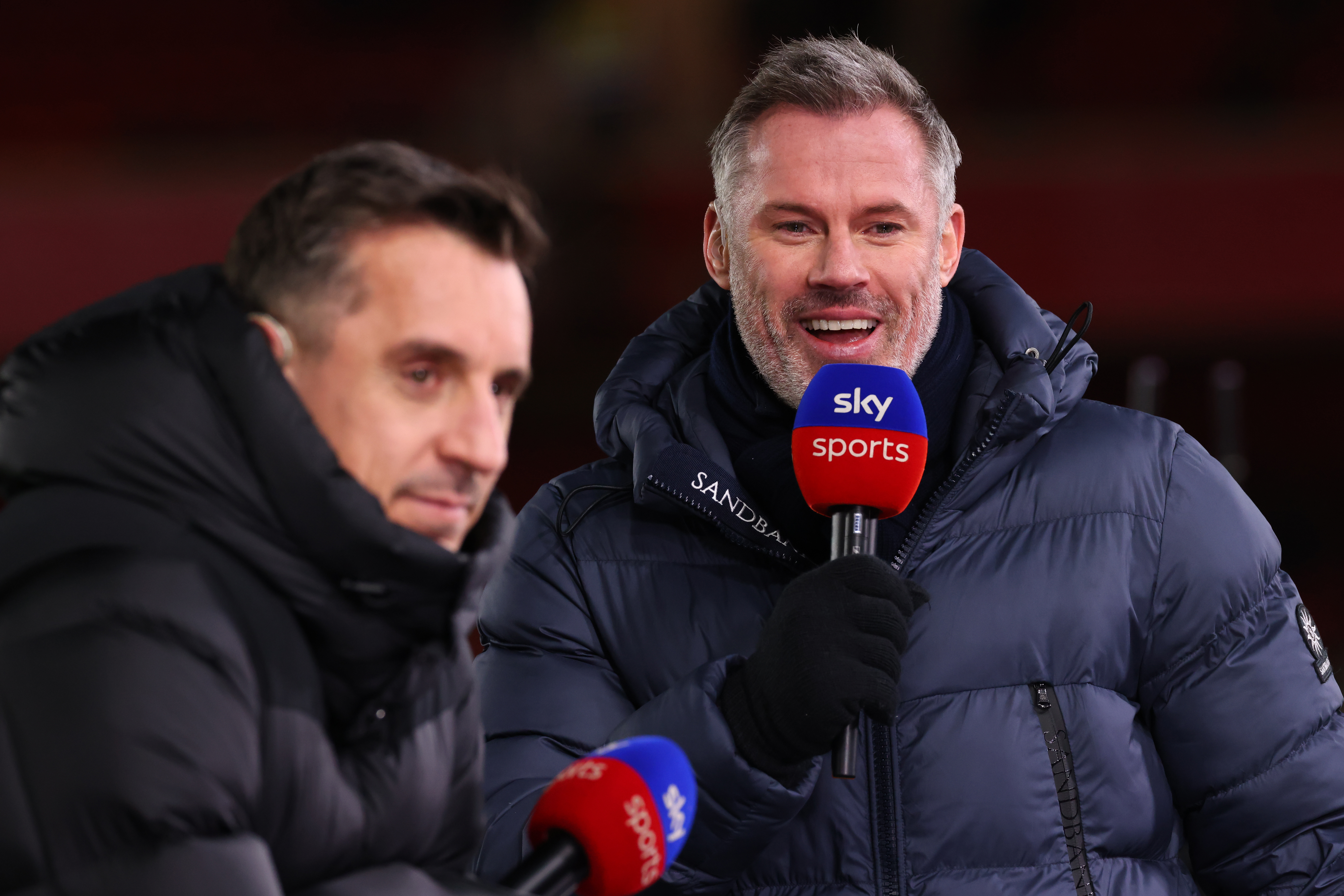When Ajax ruled the world: how Louis van Gaal nurtured his glorious mid-'90s empire
The Cruyff-inspired ‘70s team may have been their greatest in history – but in the early ’90s a new golden generation helped to make Amsterdam the capital city of Europe for a second time
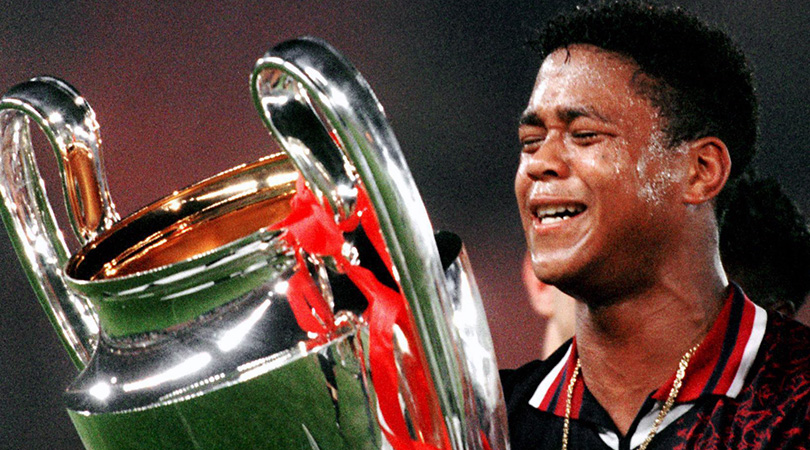
It was the night before the 1995 Champions League Final, and the biggest day of her son’s life, but Lidwina Kluivert slept well. In her slumber, she saw young Patrick come on as a substitute and score the winning goal. Her premonition was so vivid that she felt compelled to tell him the following day, as she gave him a hug and wished him good luck. Hours later, her dream came true, when the 18-year-old came off the substitutes’ bench to fire Ajax to a 1-0 win over Milan in front of 50,000 supporters at Vienna’s Ernst Happel Stadium.
On paper, the victory seemed as unlikely as Lidwina’s dream. Ajax’s team that night had an average age of 23, while 13 of the 18 players involved – among them Edgar Davids, Clarence Seedorf and Jari Litmanen – had been schooled in the academy. The Rossoneri, on the other hand, were the reigning European champions, having thrashed Barcelona 4-0 a year earlier, and had won the cup three times in seven years.
Only one player was under 26 and their squad – featuring big signings Marcel Desailly, Zvonimir Boban and Gianluigi Lentini – had been assembled at great expense.
Football utopia
But the biggest surprise was the manner in which Ajax’s Class of ’95 conquered Europe. They weaved beautiful patterns as they performed choreographed attacking moves. Every pass, sprint, shimmy and shot had a purpose and was carried out at breakneck speed. The seamless blend of elegance and athleticism was summed up by the Real Madrid coach Jorge Valdano.
“Ajax are not just the team of the ’90s, they are approaching football utopia,” he admitted. “Their concept of the game is exquisite, yet they have physical superiority as well.”
Ajax’s golden boys had overthrown football aristocracy and nobody knew quite how they’d done it.
Get FourFourTwo Newsletter
The best features, fun and footballing quizzes, straight to your inbox every week.
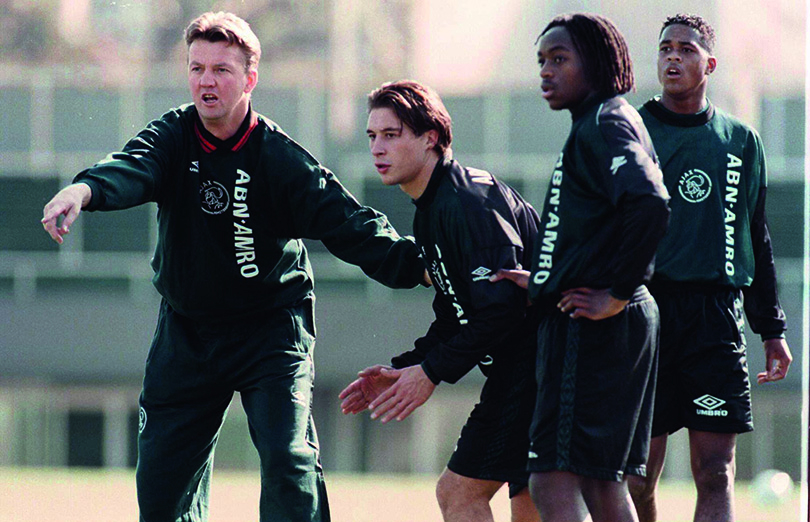
The reality was that the club were ahead of their time, and so was their boss. When Louis van Gaal replaced Leo Beenhakker in September 1991, he faced resistance from fans and the Dutch newspaper De Telegraaf, which called him “arrogant” and launched a campaign for the return of Ajax icon Johan Cruyff. The 41-year-old had relatively little coaching experience, aside from a three-year spell as their assistant manager, but his vision for the club was crystal clear.
Louis’ philosophy was based on a turbo-charged version of the Total Football style pioneered by Ajax’s legendary coach Rinus Michels. The system required players to be able to occupy any role on the pitch, so the players maintained their structure at all times. Out of possession, they would be instructed to hound opponents collectively, to retrieve the ball as quickly as possible.
It was a style that demanded technical quality, tactical intelligence and supreme athleticism. Only the most talented and selfless players could thrive in Van Gaal’s system, and he set about forming his football factory to put together a production line of players who would be a perfect fit.
His initial step was a new approach to developing Ajax’s youth and first-team players. He created an innovative three-man performance party, designed to make recruits fitter, faster and stronger than their rivals. He brought in experts from different sports whose knowledge he believed could be applied to football.
Physiologist Jos Geysel, whose methods had enjoyed success in hockey, dispensed with long-distance running training and developed more short-distance, multi-directional sprinting sessions and tests. Running coach and ex-basketball player Laszlo Jambor was hired to improve running technique, footwork and coordination, and was held in such regard that he sat in the dugout during games. But it was the last of this trio who contributed the most colourful methods to their ambitious project.
Work it
In a quiet corner of Amsterdam’s Palladium bar, away from a group of city-dwellers drinking early afternoon espressos, Rene Wormhoudt is sat tapping away on his laptop. A stocky figure with a shaven head, he was appointed the club’s strength and conditioning coach by Van Gaal after a spell working with American Football team, Amsterdam Admirals. He remained at Ajax until 2012 before taking up the same role with the national team. On his screen he watches a grainy video of the club’s famous side undergoing a training routine, many months before their European triumph.
The players, in matching red shirts, navy blue shorts and black Nike trainers, perform skipping exercises in unison inside a sports hall. The next clip shows a young Edwin van der Sar jumping sideways across a sequence of five long wooden boxes. Thirty seconds in, Wormhoudt appears wearing blue shorts and a white T-shirt, leading what seems to be a step aerobics session to Eurobeat dance music.
The best bit from 00:30
Frank Rijkaard, Ronald and Frank de Boer, along with the rest of that famous team, all march on the spot before shimmying to their left and right and kicking the air with their opposite foot. The players then spin 360 degrees and clap to the beat of the music, with the class coming to a close with a range of football-related movements, including leaping and heading an imaginary ball. Whoops of celebration and high fives greet the end of the workout.
“While I was working for Amsterdam Admirals, I noticed a greater number of athletes in that sport compared to football,” Wormhoudt tells FFT. “When I joined Ajax I felt that we could gain an advantage by training in a more specific way physically, so I invented something called soccer aerobics which we did for four years to improve speed, agility and flexibility.”
The sessions were a hit with players. “I thought it was great fun,” Ronald de Boer recalls to FFT. “The exercises made us more flexible and quicker on our feet. I felt it also helped the speed of our reactions and aided our coordination. It all fitted in nicely with the technical stuff we were doing.”
Wormhoudt also noted the physical benefits gained by players who had played different sports. “Jari Litmanen had wonderful balance and we thought it may have come from his diverse sporting background,” he says. “He had to choose between ice hockey and football when he was 14. We encouraged young players to play more sports and created sessions which weren’t specific to football.”
Ahead of their time
To measure the efficiency of every practice, each player had to wear a heart-rate monitor, while body fat was assessed repeatedly. These were Ajax’s first steps into sports science, and their approach was in contrast to methods of the era when endurance was thought to be the key physical quality required to compete at the top level.
It was a mechanical approach to developing players, and Van Gaal’s list of tactical demands also read like an instruction manual. In Louis’ world, every player was a number on the pitch, who had to carry out a specific set of tasks in and out of possession. To do this successfully, they needed to surrender individual desires for the benefit of the team.
“Football is a team sport and members of the team are dependant on each other,” he said at the time. “If certain players don’t carry out their tasks properly on the pitch, then their colleagues will suffer. This means each player must carry out his basic tasks to the best of his ability, and this requires discipline.”
Those tasks varied depending on each position. The goalkeeper had to be adept at playing with his feet as well as his hands, so he could start moves and feed the most creative centre-back. The whole team moved in set patterns; if one player dropped back to receive the ball, another had to make a run towards the opposition’s goal. The wingers were instructed to repeatedly make forward runs to open up space for a long ball from the back, while midfielders were told to stay behind the wingers at all times. If an attack couldn’t be forged down the one side, they then had to switch the ball to the opposite flank as quickly as possible. All of this was to be played out in the confines of a 4-3-3 or 3-4-3 formation.
To ensure his players carried out his demands to the letter, Van Gaal insisted on relentless rehearsals of basic exercises.
“We would focus on drilling balls to everyone’s right foot over and over again,” explains Ronald de Boer. “It became a kind of underlying challenge to move the ball from foot to foot as fast as we could. We would also practise our long-distance passes over 30 metres repeatedly, so we could switch the play at speed.
"After about three months we had mastered those exercises really well. I can remember other sessions as well, where we played six against three and the team with six would only be allowed one or two touches. After a while, the position games were executed at such a high level, and when new players arrived they would watch with open mouths.”
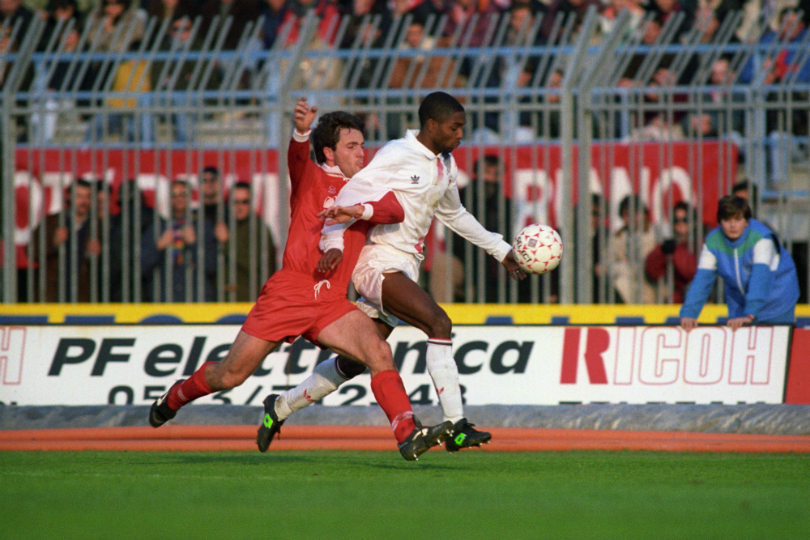
Those who failed to digest the Van Gaal manual were soon shown the door. Fan favourite Jan Wouters was flogged to Bayern Munich after losing his place to promising youngster Wim Jonk – just 12 months after being crowned Dutch Player of the Year. Bryan Roy’s individual brilliance got supporters off seats, but his apparent lack of football intelligence left his coach unimpressed.
“I no longer believe in Roy,” he said after deciding to sell him to Foggia in 1992. “I have tried everything with him, even individual training. He didn’t mind running for the team, but he couldn’t think for the team. It was impossible to improve him.”
Van Gaal was dead set on creating a perfect team in his image. After a lacklustre start, which yielded 20 points from their opening 16 games, his revolution began to gather pace. At the end of his debut season in 1991/92, Ajax finished three points short of PSV Eindhoven in the league, but lifted the UEFA Cup after an away goals win over Torino. The side consisted largely of academy players, but the success came at a price as he watched his star men being cherry-picked by wealthy Serie A clubs. Dennis Bergkamp and Wim Jonk both signed for Inter, John van ’t Schip and Marciano Vink joined Genoa, and Michel Kreek was picked up by Padova.
Homegrown success
Van Gaal was forced to start from scratch. But it proved a blessing in disguise as he opted to place his faith in the club’s next generation of talent, who he believed were even better than those who had left. Out of the ashes of one gifted group, a great one was formed over the following three seasons.
Ajax’s youngsters had spent three years being schooled in the Van Gaal talent factory and now there was a unique bond between them. There were, of course, the De Boer brothers, while Patrick Kluivert and Suriname-born Edgar Davids were childhood friends who grew up on neighbouring streets in Amsterdam. Davids was even scouted by the club on the personal recommendation of Lidwina, who had noticed his talent while he was playing with her son.
Another skilled starlet, Clarence Seedorf, was born in the same region of Suriname as Davids, while the homecoming of legend Frank Rijkaard – back after a successful five-year spell at Milan – offered vital nous as well as a father figure for the younger players to look up to in the dressing room.
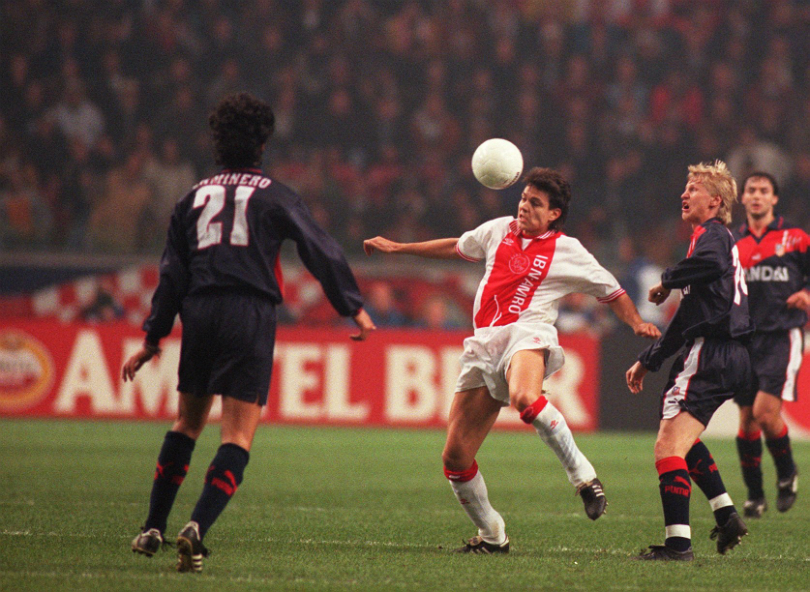
Many of them still looked like schoolboys, but they were streetwise beyond their years and their coach was eager to listen to any creative ideas. During one training session, Ronald de Boer suggested borrowing a move from basketball, known as ‘picking’, to enhance their threat from set-pieces.
At the moment a corner-kick was whipped in, he would sprint towards an opposition player who was marking one of his team-mates and deliberately block him. More often than not, this left a forward free, as De Boer’s marker fell into the trap of tracking him as he made his dart across the penalty area. Van Gaal loved it and swiftly added it to his team’s repertoire. In listening to his players, he created an environment which encouraged innovation and creativity.
Their first season together was one of transition, as holders Ajax were knocked out in the UEFA Cup quarter-finals by Auxerre and then came third in the Eredivisie. But they did at least end the 1992/93 campaign by lifting the KNVB Cup, hammering Heerenveen 6-2 in the final. The following year they won their first league title in three years, but it was in 1994/95 that Van Gaal’s work really came to fruition with the smart acquisitions of Nwankwo Kanu and Finidi George proving to be the last pieces in his puzzle.
In the league, Ajax were unbeatable, retaining the title with a record of 27 wins, seven draws and no losses. They scored an incredible 106 goals at an average of 3.12 per game.
In Europe, it soon became clear they were ready to disrupt the status quo. Holders Milan were beaten twice in the Champions League group stage, 2-0 in Amsterdam and 2-0 at San Siro a couple of months on. After the first contest, the youngsters queued up outside the Milan changing room to swap shirts with their heroes, but after the second there had been a mindset shift.
“It’s quite embarrassing when I think about it now,” says Ronald de Boer. “Ruud Gullit gave us access to the away dressing room and we were like little kids when we met up with the players after – but after the second match, we didn’t ask them for their shirts!”
Team spirit
For Frank de Boer, it was the moment when he and his team-mates began to believe.
“Something happened at the start of that season,” he has previously told FFT. “There was an incredible chemistry between the youngsters and more experienced players. Everything just felt right inside the team. There was a solid core of roughly a dozen players who could be in the first XI, and this core was then supplemented by three or four substitutes who accepted they weren’t in the starting line-up. I remember after we beat Milan, we all realised we didn’t need to fear anyone any more.”
Another advantage was the number of players comfortable playing in multiple positions. Davids – nicknamed ‘Pitbull’ by Van Gaal thanks to his tenacity – was the perfect fit for his fluid system.
“I started as a left-winger and second striker – a No.10,” Davids once told FFT. “It was Van Gaal’s idea to move my position. Marc Overmars began playing out on the left and was really good, but he felt I had the qualities to play in central midfield. On the left wing I felt isolated, but in the middle I was more part of the game.”
After romping through the group stage unbeaten, Hajduk Split and Bayern Munich were hammered 3-0 and 5-2 in the quarter-finals and semi-finals respectively. Those victories set up a third encounter with Milan in the Vienna showpiece, much to the delight of Van Gaal, who’d feared a clash against Paris Saint-Germain. “Milan play as Ajax play,” he commented. “They want to win the game, but PSG hang back and are primarily interested in avoiding defeat.”
The finalists had the same ambitions, but the players from the two teams could not have looked more different as they arrived at Vienna Airport within minutes of each other the night before the game. Ajax’s bashful youngsters looked on as Milan’s stars strolled through the arrivals lounge with their array of stunning girlfriends.
Fabio Capello had also hatched a cunning plan to catch their Dutch foes by surprise. Marcel Desailly, operating in a holding midfield role in a diamond formation, was tasked with man-marking Jari Litmanen. Striker Daniele Massaro was handed the task of stopping Frank de Boer from spraying his forward passes into midfield and forcing him to feed right-back Michael Reiziger, who was then pressed in possession.
For the first 45 minutes the ploy worked to perfection as Van Gaal’s men struggled to keep the ball in an untidy contest.
At half-time, Rijkaard had the first word. “I want the ball to be played around faster and a number of you need to play better in possession,” he said. A heated debate soon followed between Danny Blind, Clarence Seedorf and Ronald de Boer. Van Gaal happily let them go at it before making a key tactical tweak, which saw Rijkaard drop back five yards to give him more space to play key passes.
The tide began to turn in Ajax’s favour.
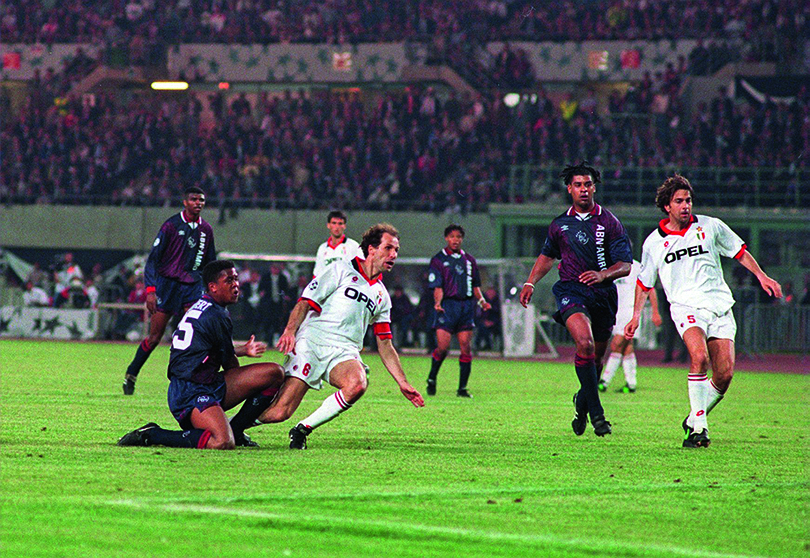
Eight minutes after the break, Kanu was introduced in place of Seedorf, and his pace forced Franco Baresi and Milan’s defence to retreat to the edge of their 18-yard box. With their dominance growing, Van Gaal – perhaps influenced by his knowledge of Lidwina’s premonition – introduced Kluivert for Litmanen after 70 minutes.
It was quite possibly the best decision of his career. Fifteen minutes later, a flowing passing move saw Overmars pick the ball up on the left wing and feed Rijkaard on the edge of the penalty area. His pass found Kluivert, who slipped past Baresi with one touch and stabbed the ball past Sebastiano Rossi with his second. Ajax were champions of Europe for the first time since 1973.
Feeding time
It was an astonishing accomplishment, turning most members of the team into household names. Upon their return to the Amsterdam, Kluivert was filmed greeting his mum at the airport and bursting into tears – at 18 he was the darling of the Dutch media. However, in the days that followed, Van Gaal was consumed by a sense of deja vu as Europe’s biggest clubs started to circle his leading lights.
Of particular interest was Litmanen, but after he committed his future to Ajax the rest of their new generation (with the exception of Seedorf, who opted to sign for Sampdoria) followed his lead and recognised they had an opportunity to dominate Europe for years to come.
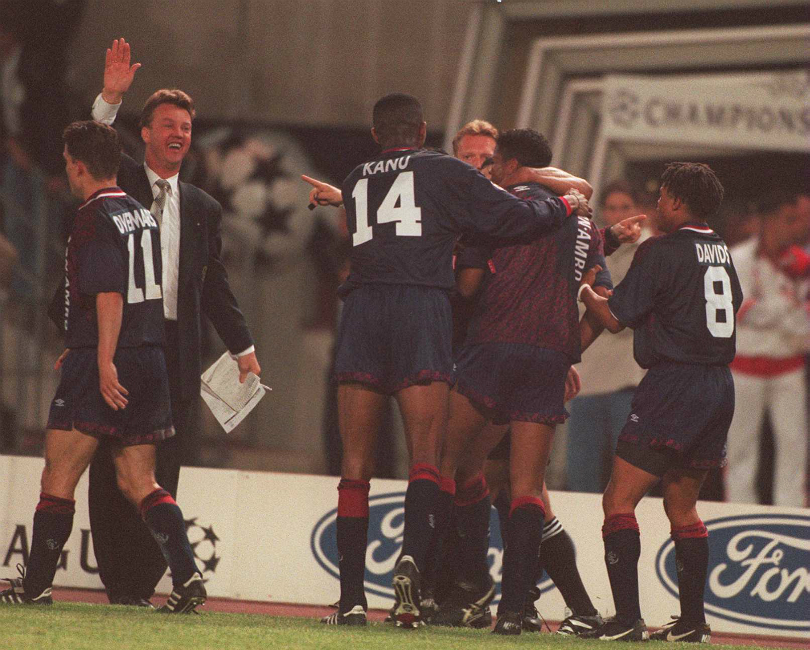
They ought to have done so, but behind the scenes things were slowly unravelling. Four months after that famous night, Kluivert was found guilty of causing a fatal car crash, souring his image and causing him to suffer from depression as he battled his guilt. Finidi George also had to contend with personal problems after his brother was shot dead in Nigeria. Results papered over the cracks as Ajax added the European Super Cup to their growing list of honours.
The decision to make a mid-season trek to Tokyo for the Intercontinental Cup – largely to satisfy commercial demands – was another source of unrest, and was blamed for a serious injury suffered by Overmars against Gremio.
Still, that didn’t stop Ajax from winning the trophy and romping to another league title. In Europe, Van Gaal’s players were applauded off the pitch by Real Madrid fans after beating Los Blancos 2-0 at the Bernabeu in the group. After overcoming both Borussia Dortmund and Panathinaikos, Ajax reached the Champions League final for the second consecutive season. Football immortality was in sight, but their efforts over the previous three years appeared to catch up with them on the night.
Ajax produced their worst display in almost two terms as they lost to Juventus on penalties after a 1-1 draw in Rome.
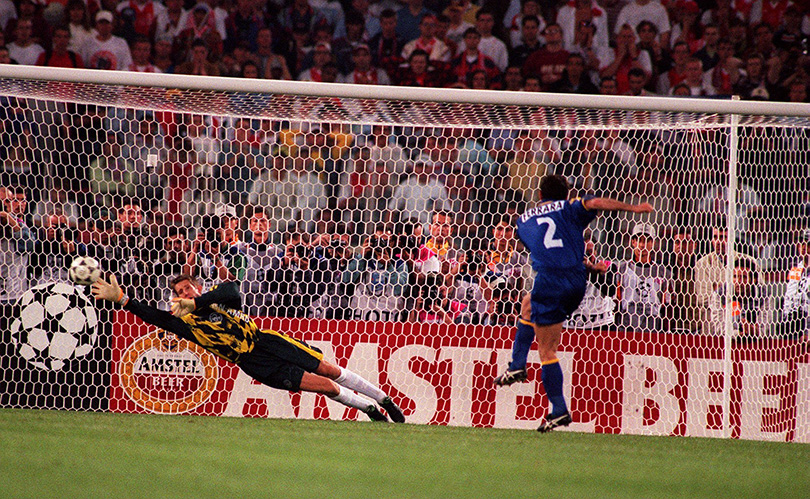
Their bubble had burst, and the Bosman ruling – introduced in 1995 and allowing players to leave for nothing at the end of their contract – eventually reduced Ajax’s house to rubble. Both Davids and Reiziger announced they were to join Milan on free transfers at the conclusion of their contracts, while George and Kanu were sold to Real Betis and Inter respectively.
Kluivert moved to Barcelona for nothing a year later at the end of a dreadful 1996/97 campaign, when Ajax came fourth in the Eredivisie to finish the season trophyless. The glory days were over, and a dispirited Van Gaal turned the lights out on a glorious era when he announced his decision to become Barça manager. The Class of ’95 had been consigned to the history books.
Gone, but certainly not forgotten.
This feature originally appeared in the February 2018 issue of FourFourTwo. Subscribe!
